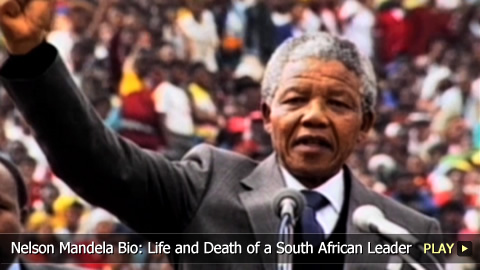Nelson Mandela Biography: Life and Death of a South African Leader

Early Life
Born July 18th, 1918 in a South African village, Nelson Mandela was first in his family to attend school. A talented student who showed rebellious tendencies early on, he was expelled from university for his involvement in a boycott against the institution. It was expected Mandela would become chief of his tribe like his father, but instead he chose to study law.
African National Congress
By 1944, Mandela joined the African National Congress, or ANC. This left-wing political party wished to give equal rights and freedoms to the entire country. Within the party, Mandela was part of a group that formed the ANC Youth League, and this offshoot used grassroots methods to get their point across, including boycotts, strikes and general civil disobedience.
Beginning of Apartheid
In 1948, the National Party was elected to government, and following that it instituted a legal system of racial segregation called apartheid. Meanwhile, Mandela and the ANCYL continued their non-violent protests against racist policies. For example, Mandela was instrumental in 1952’s Defiance Campaign, as well as 1955’s Congress of the People. He also served as a lawyer for mistreated black South Africans by opening the country’s first black law practice.
Mandela: A Target
Mandela was quickly becoming an enemy of the government, and he was targeted whenever possible. At the end of 1956, Mandela and a group of about 150 protesters were arrested on the suspicion of treason because of their advocacy. After a long trial, the group was acquitted. It was around this time that a group of militant Africans began suggesting that the peaceful approach was not working. This group formed the Pan-Africanist Congress in 1959.
Umkhonto we Sizwe and Arrest
Soon after, Mandela changed his position and proposed that armed conflict was the only way to end apartheid rule. He helped found a military offshoot of the ANC called Umkhonto we Sizwe, and this group specialized in sabotage and guerrilla warfare. Not long after, on August 5th, 1962, Mandela was arrested for a strike he had organized the previous year. He was sentenced to five years in prison; however he ended up spending his next 27 years in jail.
Rivonia Trial
While serving his five-year sentence, Mandela was also charged with sabotage, treason, and violent conspiracy during the infamous Rivonia Trial. He was sentenced to life in prison, and barely escaped the death penalty.
Imprisonment
Mandela’s first years were spent in a prison on Robben Island, but he was transferred in 1982. He was treated poorly as a black prisoner; however he did manage to earn a Bachelor of Laws degree through a correspondence program. During this time, Mandela’s profile grew and he became an international symbol of anti-apartheid resistance.
Release
On more than one occasion, the government offered Mandela his freedom in exchange for the abandonment of his beliefs. Each time, he refused. After much negotiation, Mandela was finally released on February 11th, 1990 at the age of 72 by the country’s new president.
End of Apartheid
Mandela then became president of the African National Congress, and helped negotiate the end of apartheid laws. On June 17th, 1991, the Population Registration Act was repealed, which meant that racial groups were no longer legally separated. This marked the beginning of the end of apartheid rule in South Africa.
Mandela as President
The country held its first democratic elections on April 27th, 1994, with the ANC taking 62 per cent of the vote. On May 10th, 1994 Nelson Mandela was sworn in as the first black president of South Africa. He spent his term rebuilding the economy and uniting the country. He even used the country’s National Rugby team as a rallying point for all citizens, and as a way to bring the country onto the world stage in a positive light.
Mandela's Retirement
When his term ended in 1999, Mandela retired from active politics. Despite leaving public life in 2004, Mandela convened a group of world leaders called “The Elders” in 2007. With figures like Desmond Tutu, Jimmy Carter and Kofi Annan, the group aimed to resolve world problems like poverty, AIDS and climate change.
Honors and Legacy
Among his many honors, he was awarded the Nobel Peace Prize in 1993. Even after leaving public life, Nelson Mandela is one man who continued his lifelong crusade for a better world.
